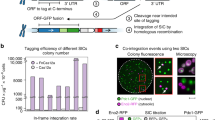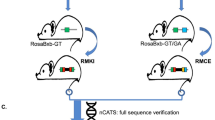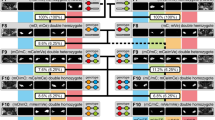Abstract
Current methods to isolate rare (1:10,000–1:100,000) bacterial artificial chromosome (BAC) recombinants require selectable markers. For seamless BAC mutagenesis, selectable markers need to be removed after isolation of recombinants through counterselection. Here we illustrate founder principle–driven enrichment (FPE), a simple method to rapidly isolate rare recombinants without using selectable markers, allowing one-step seamless BAC mutagenesis. As proof of principle, we isolated 1:100,000 seamless fluorescent protein–modified Nodal BACs and confirmed BAC functionality by generating fluorescent reporter mice. We also isolated small indel P1 phage–derived artificial chromosome (PAC) and BAC recombinants. Statistical analysis revealed that 1:100,000 recombinants can be isolated with <40 PCRs, and we developed a web-based calculator to optimize FPE.
This is a preview of subscription content, access via your institution
Access options
Subscribe to this journal
Receive 12 print issues and online access
$259.00 per year
only $21.58 per issue
Buy this article
- Purchase on Springer Link
- Instant access to full article PDF
Prices may be subject to local taxes which are calculated during checkout




Similar content being viewed by others
References
Zhang, Y., Buchholz, F., Muyrers, J.P. & Stewart, A.F. A new logic for DNA engineering using recombination in Escherichia coli. Nat. Genet. 20, 123–128 (1998).
Murphy, K.C. Use of bacteriophage λ recombination functions to promote gene replacement in Escherichia coli. J. Bacteriol. 180, 2063–2071 (1998).
Yu, D. et al. An efficient recombination system for chromosome engineering in Escherichia coli. Proc. Natl. Acad. Sci. USA 97, 5978–5983 (2000).
Skarnes, W.C. et al. A conditional knockout resource for the genome-wide study of mouse gene function. Nature 474, 337–342 (2011).
Sharan, S.K., Thomason, L.C., Kuznetsov, S.G. & Court, D.L. Recombineering: a homologous recombination-based method of genetic engineering. Nat. Protoc. 4, 206–223 (2009).
Bird, A.W. et al. High-efficiency counterselection recombineering for site-directed mutagenesis in bacterial artificial chromosomes. Nat. Methods 9, 103–109 (2012).
Sawitzke, J.A. et al. Probing cellular processes with oligo-mediated recombination and using the knowledge gained to optimize recombineering. J. Mol. Biol. 407, 45–59 (2011).
Swaminathan, S. et al. Rapid engineering of bacterial artificial chromosomes using oligonucleotides. Genesis 29, 14–21 (2001).
Jiang, W., Bikard, D., Cox, D., Zhang, F. & Marraffini, L.A. RNA-guided editing of bacterial genomes using CRISPR-Cas systems. Nat. Biotechnol. 31, 233–239 (2013).
Chalfie, M., Tu, Y., Euskirchen, G., Ward, W.W. & Prasher, D.C. Green fluorescent protein as a marker for gene expression. Science 263, 802–805 (1994).
Norris, D.P. & Robertson, E.J. Asymmetric and node-specific nodal expression patterns are controlled by two distinct cis-acting regulatory elements. Genes Dev. 13, 1575–1588 (1999).
Zhou, X., Sasaki, H., Lowe, L., Hogan, B.L. & Kuehn, M.R. Nodal is a novel TGF-β-like gene expressed in the mouse node during gastrulation. Nature 361, 543–547 (1993).
Taswell, C., MacDonald, H.R. & Cerottini, J.C. Clonal analysis of cytolytic T lymphocyte specificity. I. Phenotypically distinct sets of clones as the cellular basis of cross-reactivity to alloantigens. J. Exp. Med. 151, 1372–1385 (1980).
Mayr, E. Animal Species and Evolution 2nd edn. 182–214 (Belknap, 1965).
Provine, W.B. in Genetics, Speciation, and the Founder Principle (eds. Giddings, L.V., Kaneshiro, K.Y. & Anderson, W.W.) 43–76 (Oxford Univ. Press, 1989).
Branda, C.S. & Dymecki, S.M. Talking about a revolution: the impact of site-specific recombinases on genetic analyses in mice. Dev. Cell 6, 7–28 (2004).
Ioannou, P.A. et al. A new bacteriophage P1-derived vector for the propagation of large human DNA fragments. Nat. Genet. 6, 84–89 (1994).
Liu, P., Jenkins, N.A. & Copeland, N.G. A highly efficient recombineering-based method for generating conditional knockout mutations. Genome Res. 13, 476–484 (2003).
Poteete, A.R., Fenton, A.C. & Nadkarni, A. Chromosomal duplications and cointegrates generated by the bacteriophage lamdba Red system in Escherichia coli K-12. BMC Mol. Biol. 5, 22 (2004).
Thomason, L.C., Costantino, N., Shaw, D.V. & Court, D.L. Multicopy plasmid modification with phage lambda Red recombineering. Plasmid 58, 148–158 (2007).
Lederberg, J. Replica plating and indirect selection of bacterial mutants: isolation of preadaptive mutants in bacteria by sib selection. Genetics 121, 395–399 (1989).
Rothstein, R.J. One-step gene disruption in yeast. Methods Enzymol. 101, 202–211 (1983).
Swingle, B. et al. Oligonucleotide recombination in Gram-negative bacteria. Mol. Microbiol. 75, 138–148 (2010).
Cairns, J., Overbaugh, J. & Miller, S. The origin of mutants. Nature 335, 142–145 (1988).
Gizatullin, F.S. & Lyozin, G.T. The origin of His+ revertants of Salmonella typhimurium obtained on selective medium. Res. Microbiol. 143, 711–719 (1992).
Shoemaker, D.D., Lashkari, D.A., Morris, D., Mittmann, M. & Davis, R.W. Quantitative phenotypic analysis of yeast deletion mutants using a highly parallel molecular bar-coding strategy. Nat. Genet. 14, 450–456 (1996).
Valenzuela, D.M. et al. High-throughput engineering of the mouse genome coupled with high-resolution expression analysis. Nat. Biotechnol. 21, 652–659 (2003).
Sarov, M. et al. A recombineering pipeline for functional genomics applied to Caenorhabditis elegans. Nat. Methods 3, 839–844 (2006).
Poser, I. et al. BAC TransgeneOmics: a high-throughput method for exploration of protein function in mammals. Nat. Methods 5, 409–415 (2008).
Warner, J.R., Reeder, P.J., Karimpour-Fard, A., Woodruff, L.B. & Gill, R.T. Rapid profiling of a microbial genome using mixtures of barcoded oligonucleotides. Nat. Biotechnol. 28, 856–862 (2010).
Pfander, C. et al. A scalable pipeline for highly effective genetic modification of a malaria parasite. Nat. Methods 8, 1078–1082 (2011).
Ho, C.H. et al. A molecular barcoded yeast ORF library enables mode-of-action analysis of bioactive compounds. Nat. Biotechnol. 27, 369–377 (2009).
Wang, H.H. et al. Programming cells by multiplex genome engineering and accelerated evolution. Nature 460, 894–898 (2009).
Tester, M. & Langridge, P. Breeding technologies to increase crop production in a changing world. Science 327, 818–822 (2010).
Lezin, G., Kosaka, Y., Yost, H.J., Kuehn, M.R. & Brunelli, L. A one-step miniprep for the isolation of plasmid DNA and lambda phage particles. PLoS ONE 6, e23457 (2011).
Lezin, G., Kuehn, M.R. & Brunelli, L. Hofmeister series salts enhance purification of plasmid DNA by non-ionic detergents. Biotechnol. Bioeng. 108, 1872–1882 (2011).
Court, D.L. et al. Mini-λ: a tractable system for chromosome and BAC engineering. Gene 315, 63–69 (2003).
R Development Core Team. R: A Language And Environment For Statistical Computing (R Foundation for Statistical Computing, 2013).
Acknowledgements
We acknowledge S.K. Sharan (US National Cancer Institute) for providing mini-λ and for helpful discussions; M.L. Condic, F.S. Gizatullin, J.T. Hill and R.A. McKnight for comments on the manuscript; V. Lyozin and B. Stephan for technical help in figure preparation; and V. Boyko (US National Cancer Institute) for providing plasmids containing the coding sequences of fluorescent proteins. This work was supported by funds from the University of Utah School of Medicine's Department of Pediatrics (Neonatology) and an American Heart Association grant to L.B. (09BGIA2251076); the US National Heart, Lung, and Blood Institute Bench-to-Bassinet Consortium grant to H.J.Y. (U01HL0981); and the Intramural Research Program of the US National Institutes of Health and National Cancer Institute to M.R.K. The content of this publication does not necessarily reflect the views or policies of the Department of Health and Human Services; nor does mention of trade names, commercial products or organizations imply endorsement by the US government.
Author information
Authors and Affiliations
Contributions
G.T.L. and L.B. developed the project; G.T.L. and Y.K. performed experiments; P.C.B. carried out the mathematical analysis; A.K. analyzed mice; M.R.K. directed mouse research and provided editing; B.L.D. developed the web calculator; H.J.Y. provided research support, resources and editing; L.B. and G.T.L. wrote the manuscript; L.B. directed the overall project.
Corresponding author
Ethics declarations
Competing interests
The authors declare no competing financial interests.
Integrated supplementary information
Supplementary Figure 1 Generation of markerless targeting vectors.
A single PCR was used to generate markerless targeting vectors, i.e. including only the 720-nucleotide coding sequence of EYFP and the ~80-nucleotide homology arms flanking the first Nodal methionine. The PCR products of a few PCR tubes were combined (making up ~200 μl PCR mix) and treated as described in Methods; then precipitated with isopropanol and dissolved in 30 μl deionized water. 1 μl DNA solution (containing ~75 ng DNA) was loaded in lane1. Lane2: 1 kb plus DNA ladder. A similar approach was used for mStrawberry.
Supplementary Figure 3 Daily work schedule for the FPE procedure.
Each working day includes the end of the current FPE cycle, i and the beginning of the next enrichment cycle, i+1 (when required). It starts by doing PCR on SCs (1a) and, if a positive culture is detected, performing step 1b to calculate the number of total cells in DDC (Ni) so that the recombinant frequency fi in the positive SCs (fi = 1/Ni) can be estimated. If no positive culture is detected, steps 4a and 4b need to be repeated using more cells. Once fi is calculated, compare it with the target frequency of recombinants (fT) to determine whether enrichment is adequate or another enrichment cycle is needed (Supplementary Fig. 4). If a new enrichment cycle is needed, perform steps 3, 4a, and 4b to establish DCs as well as DDCs of the next enrichment cycle, which concludes the working day. Crossed red circles indicate positive cultures.
Supplementary Figure 4 Workflow for the FPE procedure.
The aliquot taken from the electroporation mix should contain at least one recombinant, i.e. n0,D ≥1 among N0,D total cells surviving the electroporation shock. After dilution and division of the aliquot, every positive parental SC is independent, i.e. composed of recombinant cells originating from different recombination events. Diamond shape: the target frequency (fT) is the recombinant frequency sufficient to isolate recombinants by PCR screening individual clones transferred from agar plates and grown in 96-well plates or PCR tube strips (ideally in the range of 1/1 to 1/40). LM: liquid medium. D, diluted. DD, diluted and divided. S, saturated. For details on subscripts, see Methods and Supplementary Note.
Supplementary Figure 5 Recombinants in reconstituted cell mixes can be detected with high sensitivity.
(a) Bacterial cultures containing wild type and EYFP Nodal BACs were grown separately. The wild type culture was diluted to 109 cells/ml. The EYFP culture was diluted into the wild type culture to produce different ratios of EYFP:wild type Nodal BAC containing cells. 1 μl cell mix (containing about 106 totals) was used for PCR in a 10 μl reaction mix. PCR was run for 40 cycles and all products were loaded on agarose gel. Lane one: 103 recombinants:106 totals. Lane two: 102 recombinants:106 totals. Lane three: 10 recombinants:106 totals. Lane 4: 1 recombinant:106 totals. (b) The cultures and PCRs were prepared as above, but the wild type culture was concentrated 10-fold in 5 mM MgSO4 to increase the titer to 1010 cells/ml. Here, 1 μl cell mix contained about 107 totals. PCR was run for 45 cycles. Lane one: 102 recombinants:107 totals. Lane two: 10 recombinants:107 totals. Lane three: 1 recombinant:107 totals. Note that 106 (panel a, lane four) and 107 (panel b, lane three) are the maximal, theoretical sensitivity of the assay, and approaching this limit leads to genetic drift. This means that some samples will receive one cell, others more than one, and some no cell from the same 10-6 to 10-7 cell mixes. This implies that a few PCR with different replicas of the same culture might be needed when working with recombinant frequencies close to the theoretical sensitivity of the assay.
Supplementary Figure 6 Recombinant frequencies in DDCs and the corresponding SCs coincide.
Data were obtained from Supplementary Tables 1 and 2. The recombinant frequency in DDCs was estimated as the reciprocal of the number of founders establishing the DDC, while the recombinant frequency in SCs was estimated as the fraction of recombinant clones obtained by plating an appropriately diluted aliquot of SCs on agar. The two-sided 95% confidence interval of each recombinant frequency in each experiment was calculated using the Clopper-Pearson exact method. For all PACs and BACs, the confidence interval of DDC and SC recombinant frequencies showed broad overlap and thus the null hypothesis, i.e. there is no growth difference, could not be rejected.
Supplementary Figure 7 Recombinants and nonrecombinant BACs grow similarly.
Using 100 and 120 min as time points, the growth rates between these time points can be calculated according to the formula:
The difference (Δ) between growth rates in nonrecombinants and recombinants are: ΔRP24-64L14 = -0.00432; ΔRP24-204A9 = -0.00139; ΔRP23-15D8 = 0.001486. Negative values indicate that recombinants grow faster than nonrecombinants. Rec: recombinant BAC; Non-Rec: nonrecombinant BAC. OD: optical density at 600 nm.
Supplementary Figure 8 The majority of saturated parental cultures are positive for recombinants.
EYFP targeting DNA was electroporated into recombineering electrocompetent cells as described in Methods. An aliquot of the electroporation mix was diluted and plated in a 96-well plate. Cultures were grown and genotyped for the 5' break-point. All culture PCR genotyping products were loaded in gel, but only 48 are shown. Arrows indicate PCR products.
Supplementary Figure 9 Calculating the recombination frequency using parental cultures.
A colony containing RP24-204A9(-) BAC (Supplementary Table 2) and mini-lambda was used to prepare electro- and recombineering competent cells. A 200-nucleotide oligonucleotide (oligo ID #11, Supplementary Table 3) with FRT, LoxP, and KpnI sites flanked by 63-nucleotide homology arms was electroporated into cells. An aliquot of the electroporation mix was diluted and divided in a 96-well plate so that parental cultures were established with 25 cells on average. After DDCs reached saturation, SCs were screened with primers (oligo IDs #29 and #30, Supplementary Table 3) as shown in this figure. The proportion of negative cultures was used to estimate the frequency of recombination as previously described1. The number of negative cultures was 38, the proportion of negative cultures was about 0.4, and the negative natural logarithm of the proportion (-ln 0.4) was 0.92, implying that parental cultures received on average 0.92 recombinants every 25 total cells from the recombineering mix, i.e. the recombination frequency is 0.037 or 3.7%. We similarly estimated recombination frequency in parental cultures established with seven and three total cells, and found the frequency of recombination to be 3.7% and 3% (Supplementary Table 2), respectively. A positive parental culture from the ones established with three total cells was used to isolate recombinants.
Supplementary information
Supplementary Text and Figures
Supplementary Figures 1–9, Supplementary Tables 1 and 2 and Supplementary Note (PDF 2042 kb)
Supplementary Table 3
Targeting single-stranded and priming double-stranded marker oligonucleotides and corresponding detecting primers (XLSX 15 kb)
Supplementary Software
(http://yost.genetics.utah.edu/software.php) Founder Principle-Driven Enrichment Calculator. ZIP file of the computer code used to generate the cost function analysis web calculator (ZIP 7 kb)
Rights and permissions
About this article
Cite this article
Lyozin, G., Bressloff, P., Kumar, A. et al. Isolation of rare recombinants without using selectable markers for one-step seamless BAC mutagenesis. Nat Methods 11, 966–970 (2014). https://doi.org/10.1038/nmeth.3030
Received:
Accepted:
Published:
Issue Date:
DOI: https://doi.org/10.1038/nmeth.3030
This article is cited by
-
Improved live-cell PCR method for detection of organophosphates degrading opd genes and applications
Applied Microbiology and Biotechnology (2022)
-
Identification of salt-responsive genes from C4 halophyte Suaeda nudiflora through suppression subtractive hybridization and expression analysis under individual and combined treatment of salt and elevated carbon dioxide conditions
Physiology and Molecular Biology of Plants (2020)



